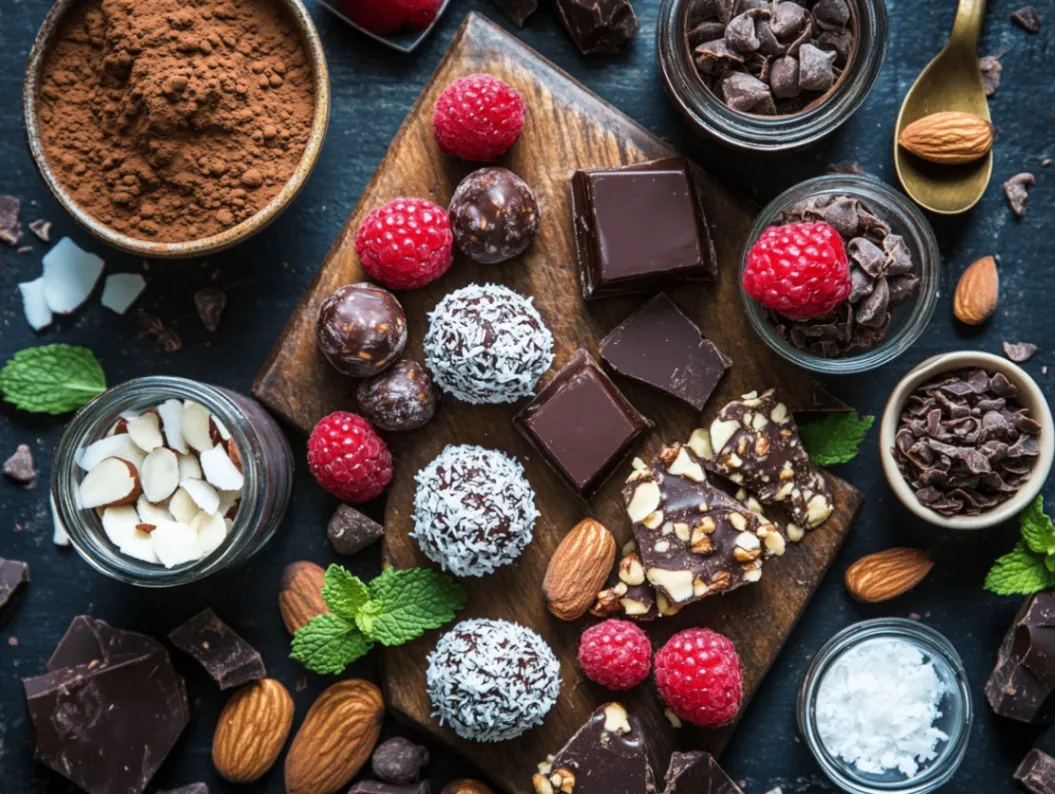Table of Contents
Table of Contents
There’s something magical about healthy chocolate that transforms an ordinary afternoon into a moment of pure bliss. As someone who’s spent countless hours in the kitchen experimenting with wholesome ingredients, I can honestly say that creating delicious, guilt-free chocolate treats has become one of my greatest passions. Let me share a personal story that changed everything for me.
Last winter, during one of those gray February days when nothing seemed to lift my spirits, I found myself standing in my kitchen staring at a pantry full of refined sugars and processed chocolate. My sweet tooth was calling, but my body was craving something nourishing. That’s when I discovered the incredible world of healthy chocolate alternatives – and trust me, it was a game-changer that revolutionized how I approach my chocolate cravings.
What makes healthy chocolate so special isn’t just its nutritional benefits, but the way it satisfies both your taste buds and your body’s need for wholesome fuel. Unlike traditional chocolate treats that leave you feeling sluggish and guilty, these healthy chocolate solutions provide sustained energy, essential nutrients, and that same rich, decadent flavor we all crave. Whether you’re a busy parent looking for nutritious snacks for the family or someone who simply wants to enjoy chocolate without compromising your health goals, these recipes will become your new favorites.
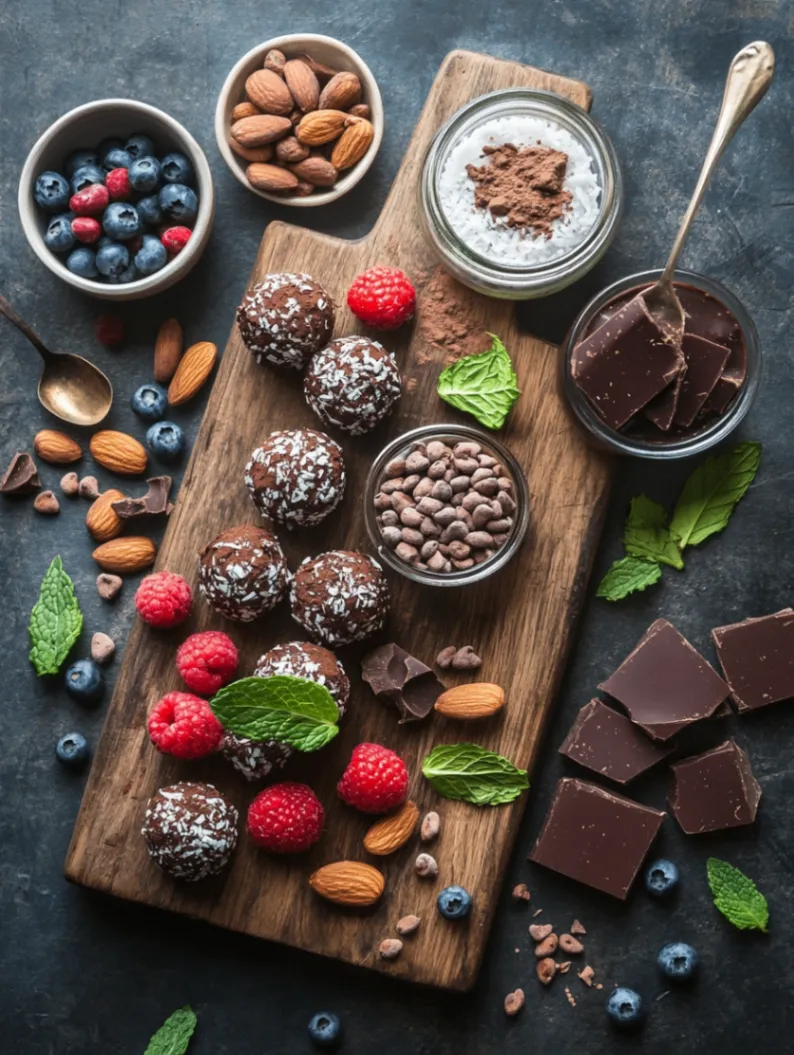
Healthy Chocolate Energy Balls
Ingredients
Nutrition
Tried this recipe?
Let us know how it was!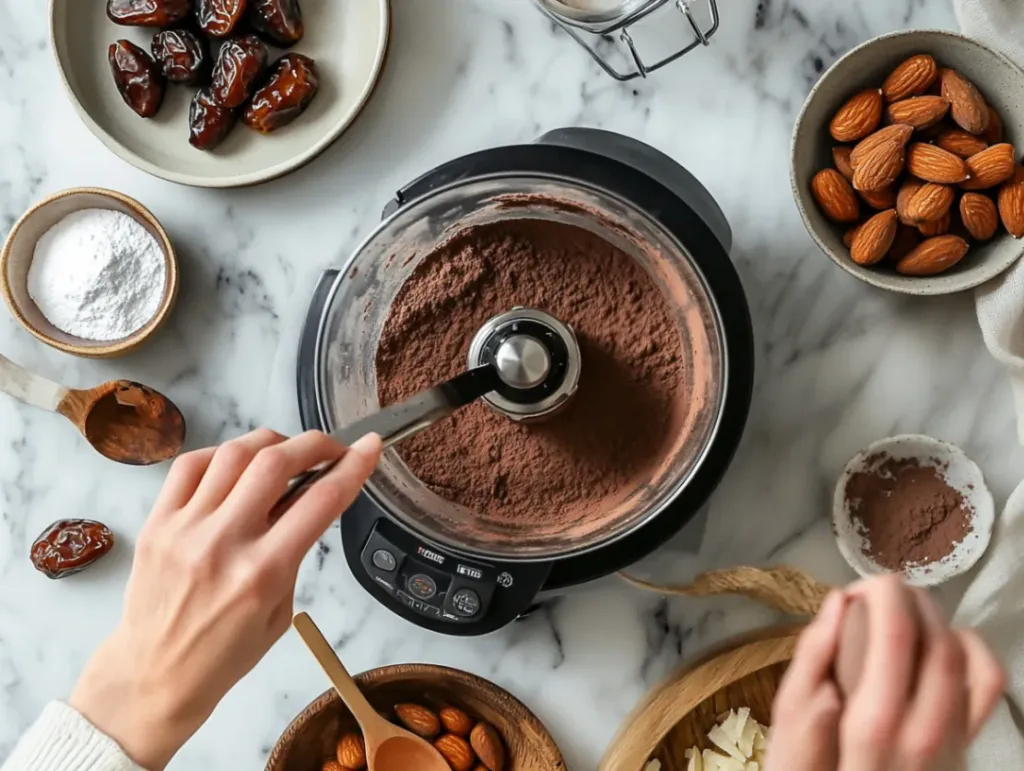
Understanding Healthy Chocolate Ingredients
The Foundation: Natural Sweeteners and Their Magic
When it comes to creating exceptional healthy chocolate treats, the sweeteners you choose make all the difference in the world. Natural sweeteners like pure maple syrup, raw honey, and dates provide complex flavors that complement chocolate beautifully while offering additional nutrients that refined sugar simply can’t match. Maple syrup brings a subtle vanilla-like undertone that enhances the richness of cocoa, while honey adds floral notes that create depth in your healthy chocolate creations.
Dates, particularly Medjool dates, have become my secret weapon for achieving that perfect chewy texture in healthy chocolate energy balls and bars. They contain fiber, potassium, and antioxidants, making them far superior to processed sweeteners. When working with dates, I always recommend soaking them in warm water for about 10 minutes before blending – this simple step transforms them into a smooth, caramel-like paste that binds other ingredients effortlessly.
Coconut sugar is another fantastic option that provides a subtle caramel flavor while maintaining a lower glycemic index than regular sugar. It works particularly well in baked healthy chocolate goods where you need the structure that granulated sweeteners provide. The key is understanding that these natural sweeteners often contain more moisture than refined sugar, so you may need to adjust your liquid ingredients accordingly.
Selecting Premium Cacao and Chocolate Components
The heart of any exceptional healthy chocolate recipe lies in choosing high-quality cacao products. Raw cacao powder offers the most intense chocolate flavor and highest concentration of antioxidants, making it perfect for smoothies, energy balls, and no-bake treats. When selecting cacao powder, look for brands that are organic and cold-pressed to ensure maximum nutrient retention.
Cacao nibs add wonderful texture and a slightly bitter, nutty flavor that pairs beautifully with sweet ingredients in healthy chocolate recipes. I love sprinkling them into homemade granola or incorporating them into chocolate bark for that satisfying crunch. They’re essentially nature’s chocolate chips – pure, unprocessed, and packed with minerals like magnesium and iron.
For melted chocolate applications, choose dark chocolate with at least 70% cacao content, or better yet, opt for sugar-free chocolate sweetened with natural alternatives like stevia or monk fruit. These options allow you to control the sweetness level while maintaining the rich, complex flavors that make healthy chocolate so irresistible. Always melt chocolate gently using a double boiler or microwave in short intervals to prevent burning and maintain that silky smooth texture.
Smart Substitutions for Every Dietary Need
Creating inclusive healthy chocolate recipes means understanding how to modify ingredients for various dietary restrictions without sacrificing flavor or texture. For those avoiding dairy, coconut cream, cashew cream, or oat milk provide rich, creamy bases that work beautifully in healthy chocolate puddings and mousses. Coconut cream, in particular, whips up wonderfully and adds a subtle tropical note that complements chocolate perfectly.
Nut-free alternatives open up healthy chocolate enjoyment for those with allergies. Sunflower seed butter, pumpkin seed butter, or tahini can replace almond or peanut butter in most recipes, each bringing its unique flavor profile. Tahini, made from sesame seeds, adds an almost savory depth that makes healthy chocolate treats more sophisticated and complex.
For binding agents in no-bake healthy chocolate recipes, ground flaxseed or chia seeds work excellently when mixed with a little water to create a gel-like consistency. These super seeds add omega-3 fatty acids and fiber while helping your treats hold together perfectly. Coconut oil serves as an excellent butter substitute, providing healthy fats that help your body absorb fat-soluble vitamins while creating that satisfying mouthfeel we associate with quality chocolate treats.
Mastering Healthy Chocolate Preparation Techniques
Essential Prep Work for Success
Proper preparation is the foundation of creating outstanding healthy chocolate treats that look professional and taste incredible. Start by organizing your workspace and measuring all ingredients before beginning – this mise en place approach prevents mistakes and ensures smooth execution. Since many healthy chocolate recipes involve temperature-sensitive ingredients like coconut oil or natural nut butters, having everything at room temperature (unless otherwise specified) creates the best consistency.
When working with dates for healthy chocolate recipes, always remove pits carefully and check for any remaining pit fragments. I learned this lesson the hard way when a small piece of pit nearly broke my food processor blade! Soaking dates in warm water for 10-15 minutes softens them significantly, making them easier to blend into silky smooth textures that bind other ingredients beautifully.
Temperature control becomes crucial when melting chocolate or coconut oil for healthy chocolate recipes. Use gentle heat and stir frequently to prevent seizing or burning. I always keep a thermometer handy when tempering chocolate – maintaining temperatures between 88-90°F ensures your finished healthy chocolate treats will have that professional snap and glossy appearance that makes them irresistible.
Step-by-Step Mastery with Professional Secrets
Creating perfect healthy chocolate treats follows specific techniques that I’ve refined through years of experimentation. When making energy balls, the key is achieving the right moisture balance – too dry and they won’t hold together, too wet and they’ll be sticky and difficult to shape. I start by processing nuts or seeds until they form a coarse meal, then add dates gradually until the mixture holds together when squeezed.
For healthy chocolate bark, temperature is everything. Melt your chocolate base slowly, then spread it evenly on a parchment-lined baking sheet. The secret to professional-looking bark is working quickly once the chocolate is spread – add your toppings like nuts, seeds, or dried fruits immediately before the chocolate begins to set. A gentle tap on the counter helps eliminate air bubbles and creates a smooth surface.
When preparing healthy chocolate smoothies or mousses, layering flavors creates depth and complexity. Start with your liquid base, add powdered ingredients like cacao gradually while blending, then incorporate frozen fruits or ice last. This sequence prevents clumping and ensures smooth, velvety textures that rival any traditional chocolate dessert. The secret ingredient I always add? A pinch of sea salt, which enhances the chocolate flavor and balances sweetness perfectly.
Avoiding Common Pitfalls
Even experienced home cooks can encounter challenges when working with healthy chocolate ingredients, but knowing what to watch for prevents frustration and wasted ingredients. Over-processing nuts and seeds is one of the most common mistakes – stop before they turn into butter unless that’s your goal. The ideal texture for most healthy chocolate energy balls is when the nuts are finely chopped but still have some texture.
Chocolate seizing happens when even small amounts of water contact melted chocolate, creating a grainy, unusable mixture. Always ensure your utensils and bowls are completely dry, and avoid covering melting chocolate as condensation can drip back into the mixture. If chocolate does seize, don’t panic – sometimes you can save it by whisking in a small amount of coconut oil or cream.
Storage timing affects texture significantly in healthy chocolate recipes. Many no-bake treats need proper chilling time to achieve the right consistency, but over-chilling can make them too hard to enjoy. I typically chill energy balls for 30 minutes, then store them at room temperature in airtight containers. For bark or chocolate coatings, refrigeration sets them quickly, but bringing them to room temperature before serving provides the best eating experience.
Serving and Perfecting Your Healthy Chocolate Creations
Creative Presentation That Impresses
Presentation transforms simple healthy chocolate treats into show-stopping desserts that guests will remember long after the last bite. Start with quality serving pieces – white plates make chocolate colors pop beautifully, while wooden boards create a rustic, artisanal feel perfect for casual gatherings. I love using small glass jars for individual healthy chocolate puddings or mousses, layering them with fresh berries or chopped nuts for visual interest.
Garnishing healthy chocolate treats elevates them from everyday snacks to special occasion desserts. Fresh mint leaves provide color contrast and a refreshing aroma that complements chocolate beautifully. Edible flowers like violets or rose petals add elegance, while a light dusting of cacao powder or coconut flakes creates professional-looking finishes. For special occasions, I drizzle melted coconut butter or cashew cream in decorative patterns that make each serving feel intentional and beautiful.
Temperature service considerations make a significant difference in how healthy chocolate treats are perceived and enjoyed. Energy balls taste best at room temperature when their flavors are fully developed and textures are optimal. Frozen healthy chocolate treats like ice cream or frozen bark should be allowed to soften slightly before serving – about 5-10 minutes at room temperature brings out their best qualities without compromising structure.
Perfect Pairings and Complementary Flavors
Understanding flavor combinations elevates healthy chocolate from good to extraordinary. Fresh berries provide natural tartness that balances rich chocolate flavors while adding vitamins and fiber. Strawberries and raspberries work particularly well with dark healthy chocolate, while blueberries complement milk chocolate alternatives beautifully. I often serve healthy chocolate energy balls alongside fresh fruit platters for balanced, satisfying snacks.
Nuts and seeds create textural contrast and provide healthy fats that help slow sugar absorption, making healthy chocolate treats more satisfying and nutritionally balanced. Almonds, walnuts, and pistachios each bring unique flavors that enhance chocolate, while pumpkin seeds and sunflower seeds offer nut-free alternatives with their own distinctive tastes. Toasted nuts and seeds develop deeper flavors that create more complex, interesting healthy chocolate combinations.
Beverage pairings can transform healthy chocolate treats into complete sensory experiences. Herbal teas like peppermint or chamomile provide soothing complements to rich chocolate flavors, while coffee or espresso creates classic combinations that never go out of style. For non-caffeinated options, golden milk with turmeric and ginger offers warming spices that pair surprisingly well with healthy chocolate, creating unique flavor profiles that guests always remember.
Storage Solutions and Longevity Tips
Proper storage extends the life of your healthy chocolate creations while maintaining their optimal taste and texture. Most no-bake healthy chocolate treats store best in airtight containers at room temperature for up to one week, though they rarely last that long in my house! For longer storage, many can be frozen for up to three months – just wrap individual portions in parchment paper before placing in freezer-safe containers.
Humidity affects healthy chocolate treats significantly, particularly those containing coconut oil or natural nut butters. In humid climates, refrigeration might be necessary to maintain proper consistency, while dry climates might require adding a piece of bread or apple slice to storage containers to prevent treats from becoming too hard. Monitor your healthy chocolate creations and adjust storage methods based on your local climate conditions.
Reheating and refreshing techniques can revive healthy chocolate treats that have lost their optimal texture during storage. Energy balls that have become too firm can be rolled between warm hands to soften slightly, while chocolate bark that has developed white bloom (harmless but aesthetically unappealing) can be gently warmed and re-tempered. Frozen healthy chocolate treats should always be thawed gradually in the refrigerator rather than at room temperature to maintain food safety and prevent texture degradation.
 DINNER
DINNER  LUNCH
LUNCH 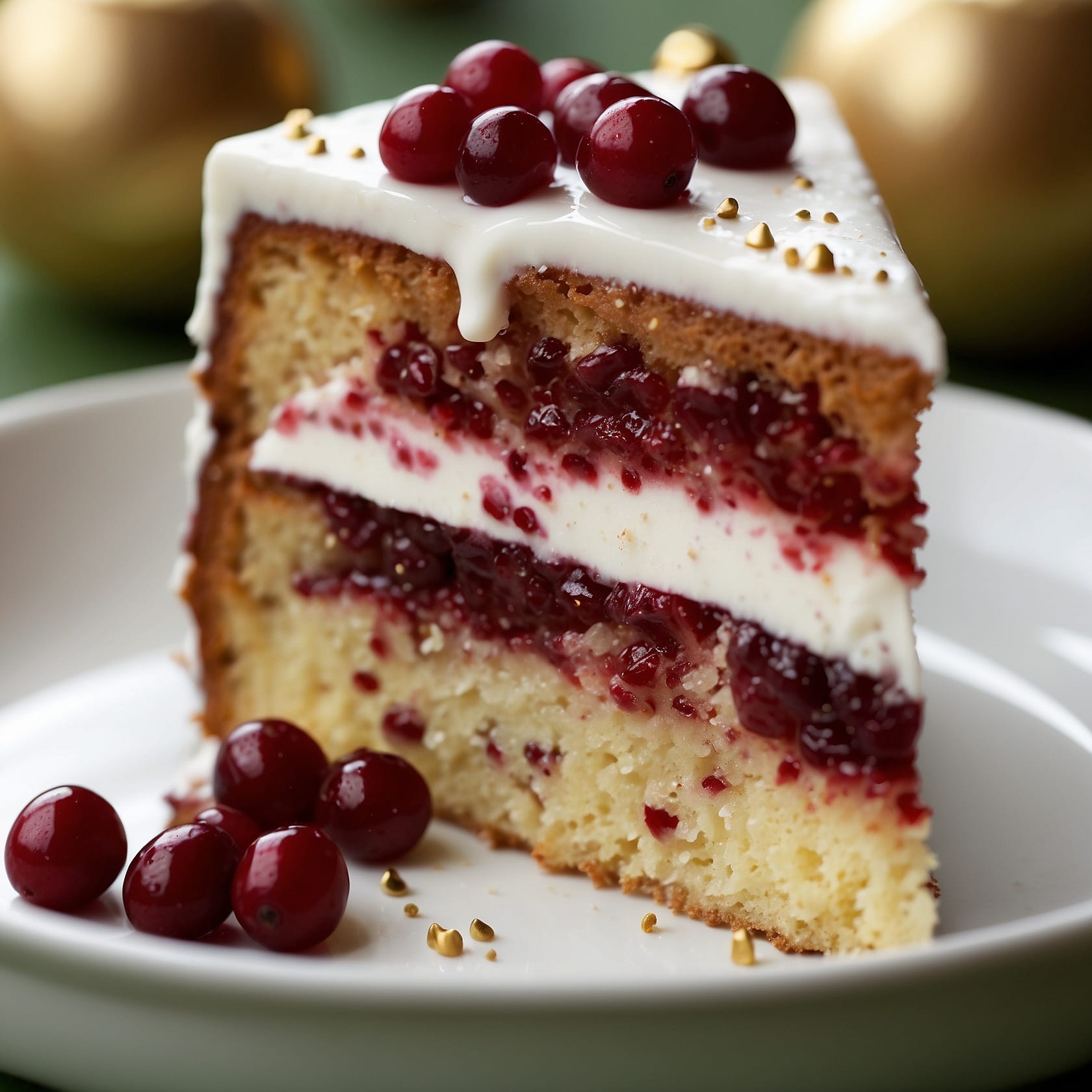 Desserts
Desserts  BREAKFAST
BREAKFAST For more amazing recipes, be sure to check out our other sections to explore a variety of ideas that will enrich your cooking experience. Each section offers its own unique flavors to ensure a delightful culinary journey:
Easy and Quick Recipes: A collection of dishes that guarantee delicious meals with minimal effort and time.
Healthy Recipes: Discover healthy and delicious options that fit your lifestyle.
Desserts: A diverse selection of sweets that will add a special touch of sweetness to your table.
Lunch Recipes: Tasty lunch ideas that you can easily prepare to delight your family.
Dinner Recipes: Delicious and easy-to-make recipes that will make your dinner a memorable occasion.
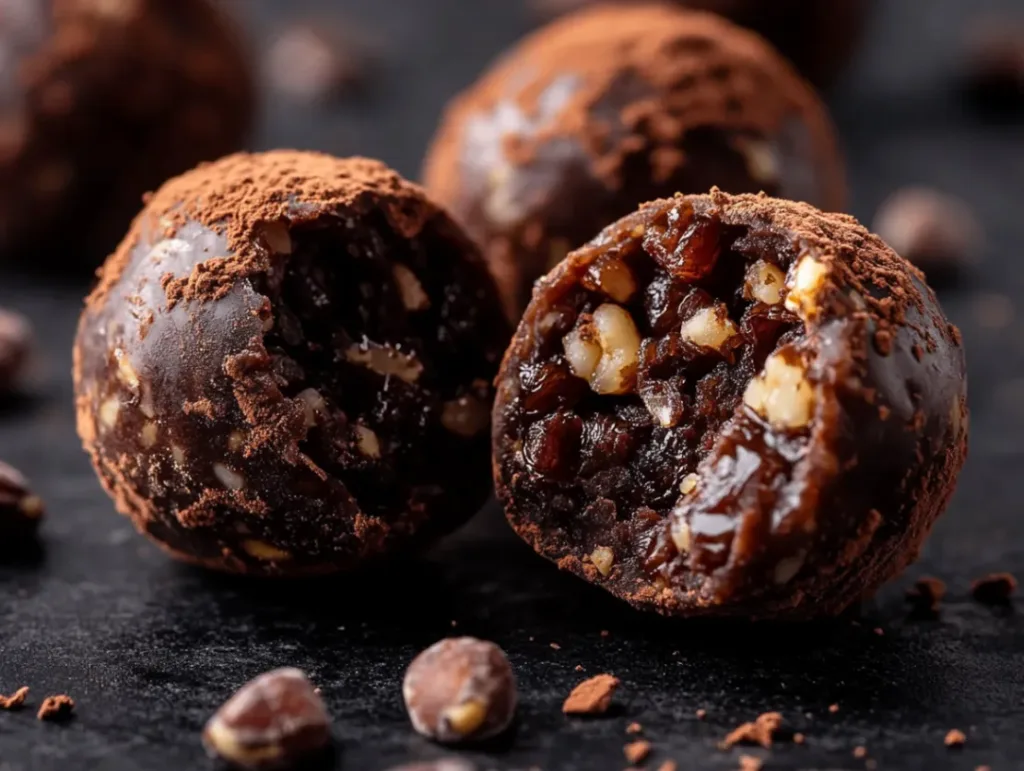
Frequently Asked Questions
Q: Can I replace regular chocolate with healthy chocolate alternatives in any recipe? A: While many substitutions work beautifully, healthy chocolate alternatives often behave differently than conventional chocolate due to different fat and sugar contents. Raw cacao powder is more intense than regular cocoa powder, so start with 3/4 of the called-for amount and adjust to taste. Natural sweeteners contain varying amounts of moisture, so you may need to reduce other liquids in the recipe. I recommend testing small batches first to perfect your healthy chocolate conversions.
Q: How do I prevent my healthy chocolate energy balls from falling apart? A: The key to cohesive energy balls lies in achieving the right moisture balance and processing technique. Start with room temperature ingredients, as cold nut butters and dates don’t bind as effectively. Process your base (usually nuts or oats) until finely ground, then add dates gradually until the mixture holds together when squeezed. If the mixture is too dry, add a tablespoon of nut butter or coconut oil. Too wet? Add more ground nuts or a tablespoon of coconut flour.
Q: What’s the best way to melt healthy chocolate without it seizing? A: Gentle, indirect heat is crucial for melting healthy chocolate successfully. Use a double boiler with simmering (not boiling) water, ensuring the bottom of the top bowl doesn’t touch the water. Alternatively, microwave in 15-second intervals, stirring between each interval. Keep all utensils completely dry, as even small amounts of water can cause chocolate to seize. If using coconut oil-based chocolate, remember it melts at lower temperatures than traditional chocolate.
Q: How long do homemade healthy chocolate treats typically last? A: Storage life depends on ingredients and storage conditions. Most no-bake healthy chocolate energy balls and bars last 5-7 days at room temperature in airtight containers, or up to 2 weeks refrigerated. Frozen treats maintain quality for up to 3 months when properly wrapped. Treats containing fresh fruits have shorter shelf lives due to higher moisture content. Always check for any signs of spoilage, especially in humid conditions, and trust your senses – if something looks, smells, or tastes off, it’s better to discard it.
Q: Can I make healthy chocolate treats if I have nut allergies? A: Absolutely! Many delicious healthy chocolate treats can be made nut-free. Replace nut butters with sunflower seed butter, pumpkin seed butter, or tahini. Use seeds like pumpkin seeds, sunflower seeds, or hemp hearts instead of nuts for crunch and protein. Coconut flour and coconut butter provide richness without nuts. Always read labels carefully, as some products are processed in facilities that also handle nuts. These alternatives often create unique, delicious flavor profiles that even non-allergic family members will love.
Embrace Your Healthy Chocolate Journey
Creating delicious, nutritious healthy chocolate treats isn’t just about satisfying cravings – it’s about nourishing your body while indulging your senses. Every time you choose wholesome ingredients over processed alternatives, you’re investing in your health without sacrificing the joy that comes from truly exceptional chocolate experiences.
The beauty of healthy chocolate lies in its versatility and the way it brings people together. Whether you’re preparing energy balls for your family’s afternoon snacks, creating elegant chocolate bark for entertaining, or whipping up a quick smoothie for breakfast, these recipes adapt to your lifestyle while supporting your wellness goals.
I encourage you to start with one recipe that speaks to you, then experiment with different combinations and techniques as your confidence grows. Share your creations with friends and family – there’s something special about seeing someone’s face light up when they realize something this delicious is actually good for them too.
Remember, the journey to mastering healthy chocolate is just as important as the destination. Each batch teaches you something new about flavors, textures, and techniques that will serve you well in all your future culinary adventures. Don’t be afraid to make mistakes – some of my best healthy chocolate discoveries happened when recipes didn’t go as planned!
I’d love to hear about your healthy chocolate adventures, so please share your experiences, modifications, and creative twists. Together, we can continue expanding the wonderful world of guilt-free indulgence, one delicious, nutritious bite at a time.
